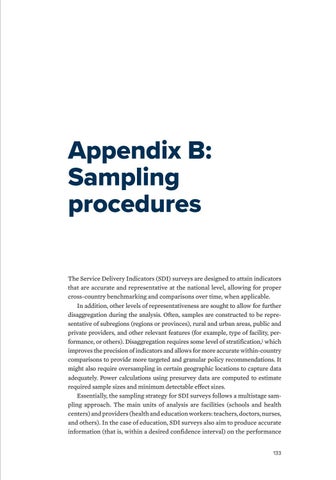Appendix B: Sampling procedures The Service Delivery Indicators (SDI) surveys are designed to attain indicators that are accurate and representative at the national level, allowing for proper cross-country benchmarking and comparisons over time, when applicable. In addition, other levels of representativeness are sought to allow for further disaggregation during the analysis. Often, samples are constructed to be representative of subregions (regions or provinces), rural and urban areas, public and private providers, and other relevant features (for example, type of facility, performance, or others). Disaggregation requires some level of stratification,1 which improves the precision of indicators and allows for more accurate within-country comparisons to provide more targeted and granular policy recommendations. It might also require oversampling in certain geographic locations to capture data adequately. Power calculations using presurvey data are computed to estimate required sample sizes and minimum detectable effect sizes. Essentially, the sampling strategy for SDI surveys follows a multistage sampling approach. The main units of analysis are facilities (schools and health centers) and providers (health and education workers: teachers, doctors, nurses, and others). In the case of education, SDI surveys also aim to produce accurate information (that is, within a desired confidence interval) on the performance 133
The Quality of Health and Education Systems Across Africa

Turn static files into dynamic content formats.
Create a flipbookArticles inside
Issuu converts static files into: digital portfolios, online yearbooks, online catalogs, digital photo albums and more. Sign up and create your flipbook.

